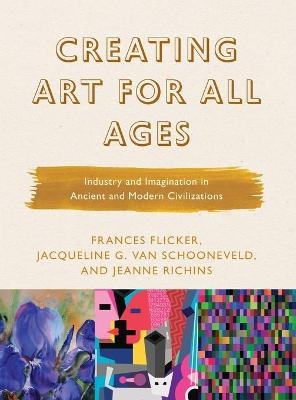
Creating Art for All Ages
Rowman & Littlefield (Verlag)
978-1-4758-4214-2 (ISBN)
This is book one of a series of three books. The series takes students on an interdisciplinary cross content journey entitled, Creating Art for All Ages. Each book provides experiences in language arts, social studies, math, and art as students investigate ancient and modern civilizations.
Industry and Imagination in Ancient and Modern Civilizations is the third book of the series and examines the generations of the Industrial Revolution, society during WWI and WWII, and Modern and Contemporary times. During the era of the Industrial Revolution, the role of the artist transformed as the patronage changed and advancements in photography were able to portray likenesses. The artist sought new avenues by using art as an expressive tool. As time progressed, artistic expression navigated the art into innovative, imaginative, and unique styles. Art became whatever the artist intended it to be.
Frances Flicker is a writer, artist, and teacher of art and humanities. Jacqueline G. Van Schooneveld is a professor of teacher education. Jeanne Richins is a lifelong educator and mixed-media artist.
Acknowledgements
Book Overview
Unit 1- The Industrial Revolution: The Beginning of the Modern Age
Chapter 1- Rococo, Neoclassicism, Romanticism, and Realism: Enlightened Visions and Differences
Lesson 1- Storytelling and Introduction: “A Visit to the Prado”
Lesson 2- Getting Good with Composition: Configured in Three Parts
Lesson 3- Seen from a Scene, an Allegorical Narrative Collage
Chapter 2- Finding Art in Science: Technology and Nature in the 19th Century
Lesson 1- Storytelling: “A Budding Imagination”
Lesson 2- Brave New Balloons: Steampunk Design
Lesson 3- Biomimicry in Art: Designing from Nature
Lesson 4- Photography: Postcards from the Heart
Chapter 3- Impressionism: Bringing in the Light
Lesson 1- Storytelling: “Monet’s Japanese Bridge”
Lesson 2- Inspired by Nature: Monet’s Bridge in Mixed-Media
Lesson 3- Cultural Links: Making Japanese Lanterns with an Impressionistic Flair
Lesson 4- Dancing Degas: Creating a Pastel Painting with a Close-up View of Nature
Unit 2- The World at Conflict: Art Responds
Chapter 4- Pointillism and Post-Impressionism: Defining Shape Differently
Lesson 1- Storytelling: Paintings to Posters, An Art of the Industrial Age
Lesson 2- Getting the Point with Pointillism: Making a Pointillist Painting
Lesson 3- Vincent Van Gogh, Post-Impressionism: A Variation on Starry Night
Lesson 4- Setting the Table with Cezanne: Creating a Diorama
Chapter 5- Fauvism, Cubism and Expressionism: A Voice of Art
Lesson 1- Storytelling: “Guernica!” Yelled Picasso
Lesson 2- Fauvism: The Wild Side of Shape and Color
Lesson 3- Cubism: Putting Together the Pieces, Making a Cubist Still Life
Lesson 4- Expressionism
Chapter 6- Surrealism and Abstract-Expressionism: Get Real!
Lesson 1- Storytelling: Art is a Symphony in Colors, Lines and Shapes
Lesson 2- Abstract-Expressionism: Feeling with Colors, Lines, Shapes and Textures
Lesson 3- Dada Makes No Sense: Making a Dada Image
Lesson 4- Beyond Reality: Making Surrealistic Artwork
Lesson 5- Abstract-Expressionism: What’s Art Got to Do with It Anyway?
Unit 3- What is Art? Art Makes Us Human
Chapter 7- Cartoon Characters and “POP” Goes the Art
Lesson 1- Storytelling: What Makes Art Go “POP”?
Lesson 2- Making a Pop Art Combined Painting Collage
Lesson 3- Say it with a Cartoon: Crafting a Cartoon Name
Chapter 8- Post WWII through Contemporary Era: Constructing Environments
Lesson 1- Storytelling: “A Special Place”
Lesson 2- Envision a Building of your own Design: Activity on Two-Point Perspective
Lesson 3- Color Field Paintings: An Intuitive Art
Lesson 4- Shadow Box Design
Chapter 9- Art is Everywhere
Lesson 1- Storytelling: Art is for Everyone
Lesson 2- Making the Most of Minimal Art: Creating a Collage
Lesson 3- Installation Art: Transforming Art
Lesson 4- A Banquet for All Ages: Connecting Civilizations
Appendix A: Handouts for Chapters 1-9
Appendix B: Foundation Lessons and Technical Reference Sheets
Lesson 1: Concepts in Art (Elements of Art and Principles of Design)
Lesson 2: Basics in Visual Composition
Lesson 3: Exploring the Emotional Impact of Color
Lesson 4: Designing with Textures
Lesson 5: Building Blocks of Shapes
Lesson 6: The Value of Values
Lesson 7: Basics for Graphite Pencil Drawing
Lesson 8: Basics for Colored Pencil Drawing
Lesson 9: Basics in Charcoal Drawing
Lesson 10: Basics on Pastels (Hard and Soft)
Lesson 11: Basics on Oil Pastels
Lesson 12: Basics on Watercolor Painting
Lesson 13: Acrylic and Tempera Painting
Lesson 14: Basics on Mixed Media and Collage
Lesson 15: Basics on Clay Hand-Building
Lesson 16: Basics in Cartooning
Appendix C: Handouts for Book Overview, Foundation Lessons and Technical Reference Sheets
Appendix D: Figures for Chapters 1-9
Bibliography
About the Authors
| Erscheinungsdatum | 10.05.2021 |
|---|---|
| Reihe/Serie | Creating Art for All Ages |
| Verlagsort | Lanham, MD |
| Sprache | englisch |
| Maße | 229 x 292 mm |
| Gewicht | 826 g |
| Themenwelt | Schulbuch / Wörterbuch |
| Sozialwissenschaften ► Pädagogik ► Schulpädagogik / Grundschule | |
| ISBN-10 | 1-4758-4214-7 / 1475842147 |
| ISBN-13 | 978-1-4758-4214-2 / 9781475842142 |
| Zustand | Neuware |
| Haben Sie eine Frage zum Produkt? |
aus dem Bereich


